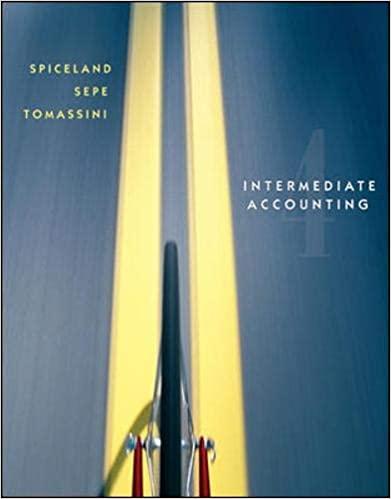Question
1.Which statement is correct regarding the treatment for interim reporting? a.GAAP requires a company to physically count its inventory at the end each quarter so
1.Which statement is correct regarding the treatment for interim reporting?
a.GAAP requires a company to physically count its inventory at the end each quarter so that it could accurately determine its ending inventory.
b.GAAP requires that the interim financial statements be audited by an independent public accountant.
c.Both a and b
d.Neither a nor b
2.Which of the following accounting changes would not be applied retrospectively on an entity's interim statements?
a.Change of the cost of inventory from the LIFO to FIFO method
b.Change of the reporting entities to include an additional subsidiary
c.Change in an estimate of the useful life of a depreciable asset.
d.None of the above (i.e. each choice would be applied retrospectively)
3.Bean Company was reasonably certain it would have an employee strike in the 2nd quarter 2019.As a result, Bean Company discounted its retail prices in order to accelerate its sales prior to the expected work stoppage.The strategy worked and sales surged in the first quarter of 2019.However, this reduced sales in the remaining quarters.Therefore, management allocated its sales over the course of its remaining quarters so that they remain consistent to prior years.
a.This is acceptable interim reporting
b.This is not acceptable interim reporting
c.
Please use the following fact pattern to respond to the following questions 12 - 13.
Sales for the first quarter of 2020 (according to the General Ledger):$100,000
Gross Profit %:25%
Beginning Inventory (January 1, 2020):60,000
Purchases over the first quarter (according to the General Ledger):80,000
4.Calculate COGS for the first quarter of 2020 by using the "gross profit percentage method
a.25,000
b.65,000
c.75,000
d.140,000
e.none of the above
13.Calculate the inventory at end of the first quarter of 2020.
a.60,000
b.65,000
c.75,000
d.140,000
e.none of the above
14- The effective income tax rate reported in the annual report is based upon:
a.Taxable Income / Income taxes payable
b.Income taxes payable / Taxable income
c.Income taxes payable / pre-tax accounting income
d.Pre-tax accounting income / Income taxes payable
Step by Step Solution
There are 3 Steps involved in it
Step: 1

Get Instant Access to Expert-Tailored Solutions
See step-by-step solutions with expert insights and AI powered tools for academic success
Step: 2

Step: 3

Ace Your Homework with AI
Get the answers you need in no time with our AI-driven, step-by-step assistance
Get Started


